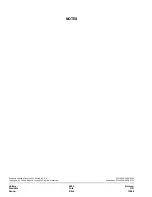
035-18549-000-B-0402
Unitary Products Group
11
Oil return will be critical during:
1.
The cooling cycle when the outdoor unit is above
the indoor unit (detail 1 of Figure 5).
2.
The heating cycle when the indoor unit is above
the outdoor unit (detail 4 of Figure 5).
When the indoor unit is above the outdoor unit, the size
of the vapor riser must be reduced to 1-1/8" OD so that
the velocity of the refrigerant will be great enough to
carry oil up the riser during the heating cycle.
When 1-1/8" OD tubing must be used for the riser, the
maximum length for the vapor line will be greatly
reduced as shown in the following examples.
EXAMPLES:
#1 - 10 Ton System
89 feet of 1-3/8" OD, type “L” copper tubing
(89 feet x 2.8 psi/100 feet) . . . . . . . . . . . . . . . . .2.5 psi
Fitting* . . . . . . . . . . . . . . . . . . . . . . . . . . . . . . . . . . . .0.5 psi
Vapor Line Pressure Drop = 3.0 psi
#2 - 10 Ton System
29 feet of 1-1/8" OD, type “L” copper tubing (vertical)
(29 feet x 8.0 psi/100 feet) . . . . . . . . . . . . . . . . .2.3 psi
7 feet of 1-3/8" OD, type “L” copper tubing (horizontal)
(7 feet x 2.8 psi/100 feet) . . . . . . . . . . . . . . . . . .0.2 psi
Fitting* . . . . . . . . . . . . . . . . . . . . . . . . . . . . . . . . . . . .0.5 psi
Vapor Line Pressure Drop = 3.0 psi
*Determine the pressure drop of the fittings for each installation - DO NOT use
the estimated values as shown in the above examples.
Although longer vapor lines are permissible, friction
losses exceeding 3 psi (2°F) will reduce system capac-
ity in both the cooling and heating cycles.
SERVICE VALVES
These outdoor units have both vapor and liquid line
service valves.
Both valves are shipped from the factory front-seated
and closed with the valve stem in the maximum clock-
wise position.
These service valves are the back-seating type and
have a 1/4" male flare access port for evacuating and
charging the system.
Shrader access valves are provided on the compressor
vapor and discharge lines for pressure checking the
system.
All access ports are sealed with a removable cap.
Never remove a cap unless the valve is fully back-
seated with its valve stem in the maximum counter-
clockwise position because the refrigerant charge will
be lost.
EXTENDING THE SERVICE PORTS
Refer to Fig.6:
1.
Loosen the screws securing the service ports in
shipping position. (See FIG 6).
2.
Push the service ports through the corner post.
3.
Tighten the screws to secure the service ports for
installation.
INSTALLATION
Since the condensing units are shipped with a holding
charge of refrigerant-22, they can be checked for a
refrigerant leak by depressing the stem on either of the
service ports that extend through the cabinet. As soon
as some internal pressure is relieved release the stem.
DO NOT release the entire holding charge.
TABLE 5: VAPOR LINES
System
Model
Refrigerant
Flow Rate,
1
(Lbs/Min)
1.
Based on Refrigerant-22 at the nominal cooling capacity of the system, a
vapor temperature of 40ºF and a liquid temperature of 105ºF. Since refriger-
ant flow rates will be a little lower at the nominal heating capacity of each sys-
tem, vapor line friction loss should always be based on cooling operation.
Type “L”
Copper Tubing
(In. OD)
Friction
Loss, 2,3
(PSI/100 Ft.)
2.
Although vapor lines should be sized for a friction loss equivalent to a 2ºF
change in saturation temperature (or approximately 3 psi), sizing the lines for
the proper return of oil is more important.
3.
These friction losses do not include any allowance for fittings. Only use a
1-1/8” riser when the indoor unit is above the outdoor unit.
EA120/FA120
30.0
1-1/8
4.7
1-3/8
1.6
TABLE 6: REFRIGERANT LINE CHARGE
1
1.
Charges are based on 40ºF suction temperature and 105ºF liquid tempera-
ture.
Refrigerant
Line
2
2.
Type “L” copper tubing.
Line Size,
OD (In.)
Refrigerant Charge
(Lb/Ft)
Liquid
3/4
0.113
Vapor
1-1/8
0.013
1-3/8










































